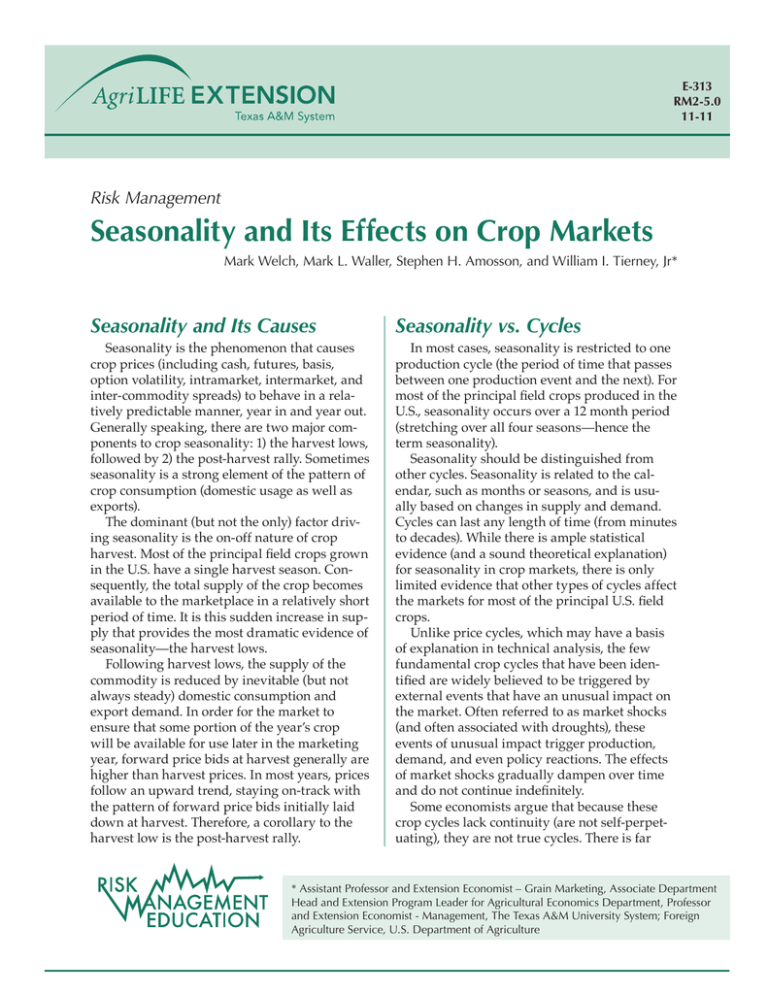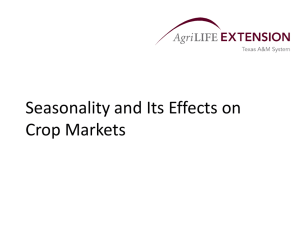Seasonality and Its Effects on Crop Markets Seasonality and Its Causes
advertisement

E-313 RM2-5.0 11-11 Risk Management Seasonality and Its Effects on Crop Markets Mark Welch, Mark L. Waller, Stephen H. Amosson, and William I. Tierney, Jr* Seasonality and Its Causes Seasonality is the phenomenon that causes crop prices (including cash, futures, basis, option volatility, intramarket, intermarket, and inter-commodity spreads) to behave in a relatively predictable manner, year in and year out. Generally speaking, there are two major components to crop seasonality: 1) the harvest lows, followed by 2) the post-harvest rally. Sometimes seasonality is a strong element of the pattern of crop consumption (domestic usage as well as exports). The dominant (but not the only) factor driving seasonality is the on-off nature of crop harvest. Most of the principal field crops grown in the U.S. have a single harvest season. Consequently, the total supply of the crop becomes available to the marketplace in a relatively short period of time. It is this sudden increase in supply that provides the most dramatic evidence of seasonality—the harvest lows. Following harvest lows, the supply of the commodity is reduced by inevitable (but not always steady) domestic consumption and export demand. In order for the market to ensure that some portion of the year’s crop will be available for use later in the marketing year, forward price bids at harvest generally are higher than harvest prices. In most years, prices follow an upward trend, staying on-track with the pattern of forward price bids initially laid down at harvest. Therefore, a corollary to the harvest low is the post-harvest rally. Seasonality vs. Cycles In most cases, seasonality is restricted to one production cycle (the period of time that passes between one production event and the next). For most of the principal field crops produced in the U.S., seasonality occurs over a 12 month period (stretching over all four seasons—hence the term seasonality). Seasonality should be distinguished from other cycles. Seasonality is related to the calendar, such as months or seasons, and is usually based on changes in supply and demand. Cycles can last any length of time (from minutes to decades). While there is ample statistical evidence (and a sound theoretical explanation) for seasonality in crop markets, there is only limited evidence that other types of cycles affect the markets for most of the principal U.S. field crops. Unlike price cycles, which may have a basis of explanation in technical analysis, the few fundamental crop cycles that have been identified are widely believed to be triggered by external events that have an unusual impact on the market. Often referred to as market shocks (and often associated with droughts), these events of unusual impact trigger production, demand, and even policy reactions. The effects of market shocks gradually dampen over time and do not continue indefinitely. Some economists argue that because these crop cycles lack continuity (are not self-perpetuating), they are not true cycles. There is far * Assistant Professor and Extension Economist – Grain Marketing, Associate Department Head and Extension Program Leader for Agricultural Economics Department, Professor and Extension Economist - Management, The Texas A&M University System; Foreign Agriculture Service, U.S. Department of Agriculture more support for the concept of cyclical influences in livestock markets (particularly cattle and hogs) than in crop markets. occurred to see if certain weather patterns necessarily followed the event in question. For example, do strong La Niña events strongly correlate with drought in North America? In commodity analysis, it is common to sepaSeasonality vs. Trends rate grain seasonals into two groups: 1) short crop Many other factors besides seasonal fluctuations years—years in which yields fell significantly below in supply and demand affect crop prices. Price the trend because of drought, freezes, floods, lack of trends are the result of gradual one-directional growing degrees, blight, etc.; and 2) normal years— changes in supply and demand that occur over a all years other than short crop years. period of time. These trends can have a powerful A 1995 study of optimal corn marketing strateinfluence on market prices and can significantly alter gies (Wisner, Baldwin and O’Brien) found that the seasonal patterns (Fig. 1). Consequently, trends and best marketing strategy in years following short other inconsistencies can cause prices to deviate subcrops was a futures hedge on 100 percent of the stantially from those that would be expected based expected production in the fourth week of Februon the crop’s seasonal pattern. ary, covered by a $.20 out-of-the money call on new crop futures that was offset in the first week of July. Conversely, in years that did not follow a short crop, the best marketing strategy was to purchase $.20 out-of-the- money puts on new crop futures on 80 percent of expected production in the third week of May, hedge with futures the remaining 20 percent in the first week of July, and offset the puts in the second week of September. Another criterion commonly used to discriminate between years is to examine years when Figure 1. Relationship between seasonal, cyclical and trend effects on prices for a another major fundamental suphypothetical crop. ply/demand factor changed. For example, crop prices may have a distinctive pattern in years in which two events Normal vs. Conditioned Seasonals occurred—both total beginning supplies and ending The normal seasonal pattern that prevails can be stocks increased. The logic of this type of seasonal is estimated as the average of all years or the averthis: “Did prices behave differently in years in which age of the majority of years deemed to be free of the market had to struggle with a persistent, yearunusual market shocks. Or, a conditioned seasonal long over supply of the crop (over supply relative to could be constructed using data from years in the final quantity consumed)?” which a specific condition is applied. Sometimes It is sometimes useful to construct a conditioned referred to as analog modeling, it is a technique seasonal, picking the appropriate years based not commonly used in forecasting other things besides on a particular supply/demand fundamental but on commodity prices. For example, meteorologists an unusual price phenomenon. For example, if the often look for distinctive and anomalous weather December corn futures contract set a new life-ofphenomena. If a particular unusual weather event is contract low in July (a month in which the contract present in the current period (such as the occurrence normally is setting its high), is that a reliable predicof an El Niño or a major volcanic eruption), then tor that the contract will trade lower in the succeedmeteorologists look at past years when these events ing months? 2 table for the December corn contract. The calendar year contract highs tend to cluster in late spring to early summer with contract lows more dispersed, but generally in the second half of the year. Timing and Magnitude of Price Changes There are two purposes of seasonal analysis: 1) to correctly identify the timing of a season’s high and low; and 2) to estimate the magnitude of the difference Figure 2. 10-year Average Wheat Price Index (2001-2011) and Conditional Seasonal between the high and low price. Wheat Price Index Sometimes market analysts rely on timing to identify the seaOne example of a seasonal of this type is prosonal lows (which may be more consistent than the vided in Figure 2. It examines the pattern of wheat highs) and then rely on magnitude to predict the prices in years when the January price was close to high. For example, a particular crop’s seasonal low or below the preceding July price (something which may have occurred in October-November 80 percent occurred in 1989, 1990, 1996, 2009, and 2010). Clearly, of the time. The seasonal high was 12 to 15 percent this phenomenon is associated with even weaker above the seasonal low 75 percent of the time. Based prices in the February-May period. on this analysis, one would expect the seasonal low Another method of checking for seasonal patto come at harvest (in October or November) and the terns is the seasonal high-low table (see Schwager, high to be 12 to 15 percent above the low. 1984). This method simply requires identification of Of the two, timing is the more important for the season of interest and recording the months in speculative purposes, whereas magnitude is often which the highs and lows occurred over a number more important for hedging purposes. of years. Table 1 provides an example of a high-low Farmers (or other hedgers) may make or lose money in their commodity futures/options accounts, but the ultimate profitability of the Table 1. Month of High and Low of December Corn Contract during the January to December Period agricultural enterprise depends on the net profit of the crops Contract Jan Feb Mar Apr May Jun Jul Aug Sep Oct Nov Dec year produced (net any futures/ options gains or losses). It fol2000 H L lows, therefore, that a farmer 2001 H L should be more interested in 2002 L H selling a crop at a profitable 2003 L H price than selling it at the sea2004 H L sonal high. 2005 H 2006 L L 2007 H 2008 H 2009 H 2010 L H L L L H 3 References Wisner, Robert, Baldwin, Dean and O’Brien, Dan. “An Evaluation of Pre-Harvest Corn Futures and Option Marketing Strategies in Selected Iowa and Nebraska Locations.” Department of Agricultural Economics, Iowa State University, 1995. Schwager, Jack D. A Complete Guide to the Futures Markets. New York: John Wiley and Sons, 1984. Partial funding support has been provided by the Texas Corn Producers, Texas Farm Bureau, and Cotton Inc.–Texas State Support Committee. Produced by Texas A&M AgriLife Communications Extension publications can be found on the Web at AgriLifeBookstore.org Visit the Texas AgriLife Extension Service at AgriLifeExtension.tamu.edu Educational programs of the Texas AgriLife Extension Service are open to all people without regard to race, color, sex, disability, religion, age, or national origin. Issued in furtherance of Cooperative Extension Work in Agriculture and Home Economics, Acts of Congress of May 8, 1914, as amended, and June 30, 1914, in cooperation with the United States Department of Agriculture. Edward G. Smith, Director, Texas AgriLife Extension Service, The Texas A&M System. Revision



